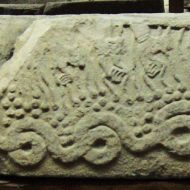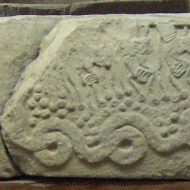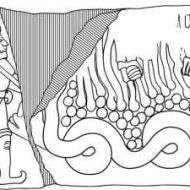Illuyanka : The Serpent Dragon
Listen
At a glance
| Description | |
|---|---|
| Origin | Hittite Mythology |
| Classification | Animals |
| Family Members | NA |
| Region | Turkey, Syria |
| Associated With | Storm God |
Illuyanka
Introduction
Illuyankas, also known as the serpent-demon, was a fearsome creature from the Hittite myth. He was often regarded as the enemy of the storm god Taru and the Hurrian deity Teshub.
The Illuyankas dragon-slaying tale originated from the Hittites’ mythology. It is believed to have inspired other myths, such as those about Typhon and Zeus. The storm god was able to defeat the dragon in various Illuyankas-based myths. In some instances, he received help from his daughter Inara and Hupasiyas, while in others, his son was the one who helped.
Physical Traits
Illuyankas was described as a massive serpent with multiple heads. He was also a dragon of chaos.
Powers and Abilities
After defeating the storm god at Kiskilussa, Illuyankas almost destroyed all creation. Due to his dangerous nature, the weather god sought the help of other gods and humans. One of the Illuyankas cycles involved the dragon taking the eyes and heart of the storm deity. The creation was threatened by Illuyankas, who encircled the deities in his enormous coils and devoured their hearts and eyes.
The goddess Inara prepared a grand feast for the gathering, which included an abundance of alcohol. She enlisted the help of Hupasiyas to trick the dragon. He agreed to help Inara as long as he could be the goddess’ lover. She then went to the serpent’s lair to lure Illuyankases. When Illuyankas and his family went to the feast, they became bloated and drunk. Hupasiyas was able to bind all of the dragons together. The storm god then appeared and killed them, scattering their remains all over the Earth.
Modern Day Influence
The story of the battle between Illayukas and the storm god is told at the feast of purulli. It is believed that after his initial defeat, the storm god wanted to celebrate the fertility and prosperity of the people at the feast. Taru, the storm deity, represented the time of harvest and crops, while Illayukas was the winter serpent.
Related Images
Frequently Asked Questions
What is lorem Ipsum?
I am text block. Click edit button to change this text. Lorem ipsum dolor sit amet, consectetur adipiscing elit. Ut elit tellus, luctus nec ullamcorper mattis, pulvinar dapibus leo.
What is lorem Ipsum?
I am text block. Click edit button to change this text. Lorem ipsum dolor sit amet, consectetur adipiscing elit. Ut elit tellus, luctus nec ullamcorper mattis, pulvinar dapibus leo.
What is lorem Ipsum?
I am text block. Click edit button to change this text. Lorem ipsum dolor sit amet, consectetur adipiscing elit. Ut elit tellus, luctus nec ullamcorper mattis, pulvinar dapibus leo.
What is lorem Ipsum?
I am text block. Click edit button to change this text. Lorem ipsum dolor sit amet, consectetur adipiscing elit. Ut elit tellus, luctus nec ullamcorper mattis, pulvinar dapibus leo.
What is lorem Ipsum?
I am text block. Click edit button to change this text. Lorem ipsum dolor sit amet, consectetur adipiscing elit. Ut elit tellus, luctus nec ullamcorper mattis, pulvinar dapibus leo.









